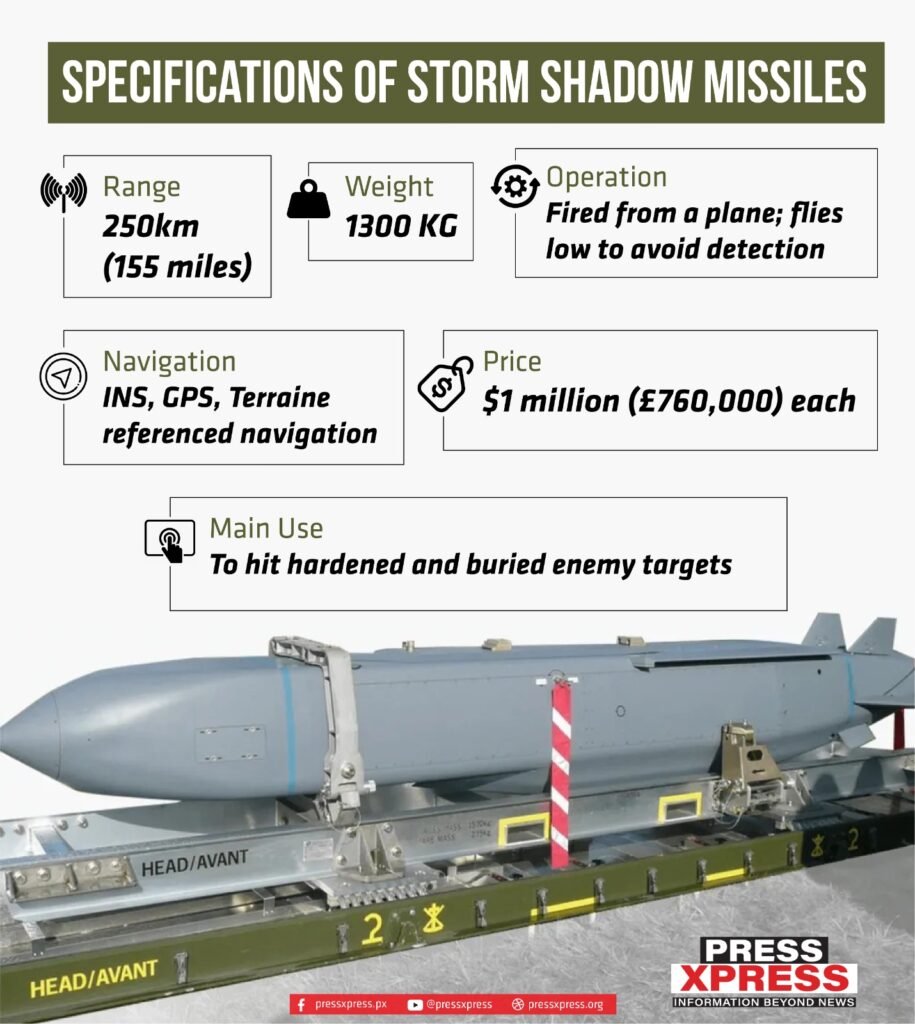Ukraine has reportedly used British-made Storm Shadow and US-made ATACMS missiles to strike deep into Russian territory, marking a significant escalation in its counteroffensive and raising questions about the broader implications for the ongoing conflict
Ukraine’s reported use of British-made Storm Shadow missiles and US-made ATACMS to strike targets within Russian territory marks a significant development in the ongoing war. These missile strikes signal Kyiv’s intent to escalate its counteroffensive, utilizing advanced Western weaponry to target Russian supply chains and strategic assets deep behind enemy lines.
However, the growing reliance on foreign-supplied long-range weapons raises important questions about the broader implications of such actions on the war’s trajectory and the risk of unintended consequences.

A Shift in Ukraine’s Strategy?
On Tuesday, Ukraine used US-made ATACMS missiles to target a Russian ammunition depot in Bryansk, deep inside Russian territory. The strike reportedly caused extensive damage, with secondary explosions indicating the destruction of large quantities of munitions. Ukrainian forces launched eight missiles, and while Russian interceptors claimed to neutralize some, the attack succeeded in hitting its primary target.

This image was made from a video posted by a Telegram channel affiliated with the Ukrainian military on Tuesday, Nov. 19, 2024. The channel says it shows a U.S.-supplied ATACMS missile being fired from an undisclosed location in Ukraine.
On Wednesday, Ukraine reportedly deployed UK-made Storm Shadow missiles in the Kursk region, striking targets near the Russian village of Marino, approximately 35 miles from the border. Fragments of Storm Shadow missiles were identified at the scene, and explosions were documented through geolocated videos. These strikes, targeting key logistical nodes, underline Ukraine’s expanding range of operations and its intent to disrupt Russian supply chains and military infrastructure.
Ukraine’s Defense Minister Rustem Umerov refrained from confirming the use of Storm Shadow missiles during a recent press conference, maintaining a position of strategic ambiguity. “We’ll be defending and giving punches back… with all the means available,” he stated. This posture underscores Ukraine’s intent to keep Russia uncertain about its military capabilities while signaling to Western allies its commitment to utilizing advanced weaponry effectively.

The Role of Western-Supplied Weaponry
The UK-supplied Storm Shadow missiles, with a range of approximately 250 kilometers (155 miles), and the US-made ATACMS, capable of striking targets up to 186 miles away, offer Ukraine significant new operational capabilities. These weapons are powerful tools designed for precision strikes, capable of penetrating fortified bunkers and neutralizing high-value targets with minimal collateral damage. Their deployment into Russian territory sends a clear message about Kyiv’s willingness to escalate its counteroffensive.
However, the use of these weapons also raises the stakes. The US, under the outgoing President Joe Biden and the UK have previously limited the supply of such weapons to defensive operations within Ukrainian borders, now face questions about the escalation of hostilities. By enabling strikes on Russian territory, Western nations risk being perceived as complicit in Ukraine’s expanded military campaign, potentially drawing deeper international scrutiny.
Escalation Risks and Diplomatic Concerns
Ukraine’s expansion of strikes into Russian territory introduces significant risks. While Kyiv frames these attacks as necessary responses to Russian aggression, the perception of direct attacks on Russian soil may harden Moscow’s resolve and complicate prospects for negotiation. Additionally, the deployment of Western-supplied weapons in cross-border operations could strain relations with key allies, particularly if Russia leverages the narrative that these nations are directly enabling aggression.
On the international stage, Ukraine’s strikes risk complicating its diplomatic standing. While Western support for Kyiv remains robust, actions perceived as escalation could create divisions among allies. Some countries may hesitate to supply further advanced weaponry out of concern for provoking Russia or diminishing prospects for de-escalation.
President Volodymyr Zelensky’s recent statement highlights Ukraine’s growing arsenal of long-range capabilities, including domestically produced drones and cruise missiles like the Neptune. This diversification of military assets underscores Ukraine’s determination to maintain pressure on Russian forces. However, as Ukraine increases its military reach, it must balance immediate operational objectives with the long-term goal of securing sustained international support.
What Lies Ahead?
The use of long-range missiles marks a pivotal moment in the war, reflecting both the evolution of Ukraine’s military strategy and the intensifying nature of the conflict. However, questions about the broader implications of these strikes loom large. Can Ukraine sustain its offensive momentum without overextending its resources or alienating key allies? Will these operations force Russia to rethink its logistical strategies, or will they trigger a cycle of escalation that increases risks for all parties involved?
For Ukraine, the stakes are high. Precision strikes on Russian infrastructure may yield tactical gains, but they must be weighed against the potential diplomatic fallout and the increased likelihood of retaliatory escalation. As the war enters its next phase, the challenge for Kyiv lies in maximizing the impact of its expanded capabilities while maintaining the international support critical to its survival. Striking this balance will require careful calibration of its military actions and a nuanced approach to managing its alliances.
Lastly, as Ukraine expands its military reach, the balance between tactical gains and the potential diplomatic fallout remains delicate. Whether this strategy pressures Russia into recalibrating its logistical approach or triggers retaliatory actions that escalate the war further is yet to be seen. For Kyiv, balancing tactical success with long-term strategic considerations is critical as the conflict evolves in unpredictable ways.


